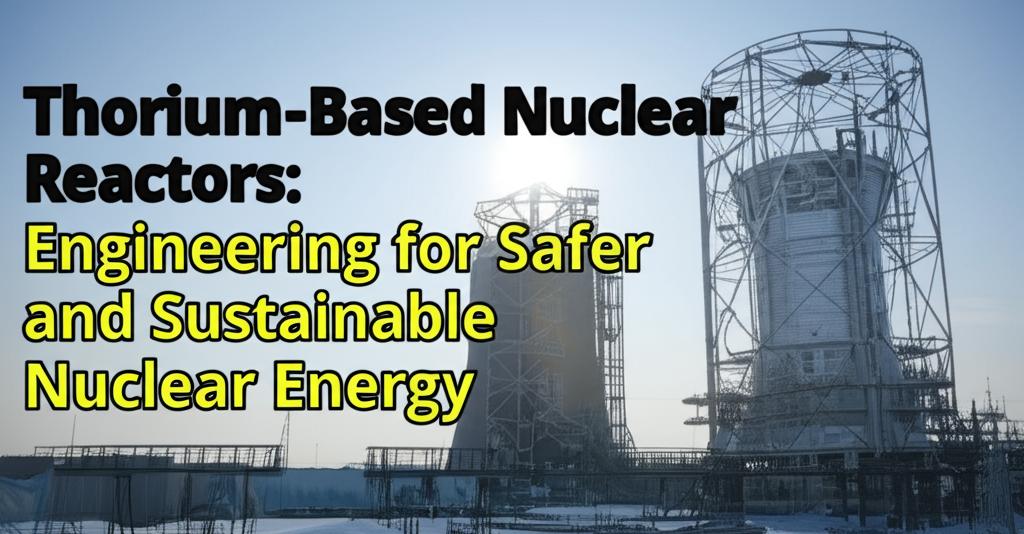Thorium-based nuclear reactors are gaining increasing attention as a potentially transformative technology for safer and more sustainable nuclear energy production. This approach offers several key advantages over traditional uranium-fueled reactors, positioning it as a promising contributor to the future global energy landscape.
Enhanced Safety and Reduced Proliferation Risks:One of the most significant engineering aspects of thorium reactors is their inherent safety features. Thorium itself is a fertile material, not fissile, meaning it cannot sustain a nuclear chain reaction on its own. It requires an external neutron source (often uranium-233, uranium-235, or plutonium-239) to initiate the process. In a reactor, thorium-232 absorbs a neutron, transforming into uranium-233, which then fissions and releases energy. This process offers better control.
Molten Salt Reactors (MSRs), which are particularly well-suited for thorium fuel, operate at lower pressures than traditional water-cooled reactors. This significantly reduces the risk of explosive meltdowns. In some MSR designs, if the reactor overheats or loses power, a frozen salt plug melts, allowing the molten salt fuel to drain into a passively cooled containment tank, naturally stopping the reaction and preventing the release of radioactive materials.
Furthermore, the thorium fuel cycle produces significantly less plutonium and other long-lived transuranic elements compared to the uranium fuel cycle. The uranium-233 produced is also more difficult to weaponize due to the presence of uranium-232, which decays into thallium-208, a strong gamma emitter, making handling more hazardous and detection easier. This inherent proliferation resistance is a key advantage.
Sustainability and Fuel Abundance:Thorium is estimated to be about three to four times more abundant in the Earth's crust than uranium. This vast availability offers long-term energy security, with some estimates suggesting that known thorium reserves could power the globe for centuries, or even millennia. Countries like India and China, which have substantial thorium deposits, are actively pursuing thorium reactor technology to leverage these domestic resources.
Moreover, thorium offers the potential for breeding fissile material (uranium-233) more efficiently in thermal reactors than uranium can breed plutonium. This means a thorium reactor can, in principle, produce more fuel than it consumes, leading to a highly sustainable fuel cycle. The efficiency of thorium also means that a smaller amount of fuel can produce a larger amount of energy.
Waste Management Benefits:Thorium-based fuel cycles generate significantly less long-lived radioactive waste. The waste that is produced has a shorter half-life, meaning it decays to safe levels much faster than the waste from uranium reactors (hundreds of years versus tens of thousands of years). This considerably lessens the burden of long-term geological storage and reduces environmental concerns.
Engineering Advancements and Current Developments:Significant engineering progress is being made in thorium reactor technology, particularly with MSRs. These reactors utilize liquid fuel, often a mixture of fluoride or chloride salts containing thorium and uranium. This liquid form allows for continuous online reprocessing, where fission products that can "poison" the chain reaction are removed, and new fuel can be added without shutting down the reactor.
China has been at the forefront of recent developments, with reports of its experimental thorium-fueled molten salt reactor (TMSR-LF1) in the Gobi Desert achieving operational milestones, including refueling while running. This facility serves as a crucial proof-of-concept for the technology's viability and scalability. India has also maintained a long-term, three-phase nuclear program with the ultimate goal of utilizing its vast thorium reserves in Advanced Heavy Water Reactors (AHWRs) and other designs.
Other reactor types, like High-Temperature Gas-Cooled Reactors (HTGRs) using TRISO (TRi-structural ISOtropic) particle fuel, can also effectively utilize thorium, offering high thermal efficiency and passive safety features.
Challenges and the Path Forward:Despite the numerous advantages, the widespread commercialization of thorium-based reactors faces several engineering and economic hurdles. These include:
- Higher Upfront Costs: The initial investment for developing and building new reactor designs and the associated fuel cycle infrastructure can be substantial, especially when compared to established uranium reactor technology.
- Reprocessing Complexity: While online reprocessing in MSRs is an advantage, the chemical processing of thorium fuel, particularly separating uranium-233 and managing byproducts like protactinium-233, presents technical challenges. The high radioactivity of separated U-233 (due to U-232 contamination) necessitates remote handling and shielded facilities, adding to costs.
- Need for a Fissile Starter: Thorium reactors require an initial fissile material to start the chain reaction. This can be enriched uranium or plutonium, which ties the thorium cycle, at least initially, to the existing uranium infrastructure.
- Limited Operational Experience: Compared to the decades of operational data from uranium reactors, thorium reactors, particularly advanced designs like MSRs, have less extensive large-scale, long-term operational experience. More research, development, and demonstration projects are needed to build confidence and refine designs.
- Regulatory Frameworks: Existing nuclear regulatory frameworks are largely based on uranium-fueled reactors. Adapting or developing new regulations for thorium-based systems will be necessary.
Despite these challenges, the potential benefits of enhanced safety, superior sustainability, reduced waste, and fuel abundance continue to drive research and development globally. As nations strive for cleaner and more secure energy sources, thorium-based nuclear reactors represent a compelling engineering pathway toward a new generation of nuclear power. Continued international collaboration, investment in research and pilot projects, and addressing the remaining technical and economic challenges will be crucial for realizing the full potential of thorium. Innovations in materials science, fuel fabrication, and reprocessing techniques are key areas of ongoing engineering focus.

